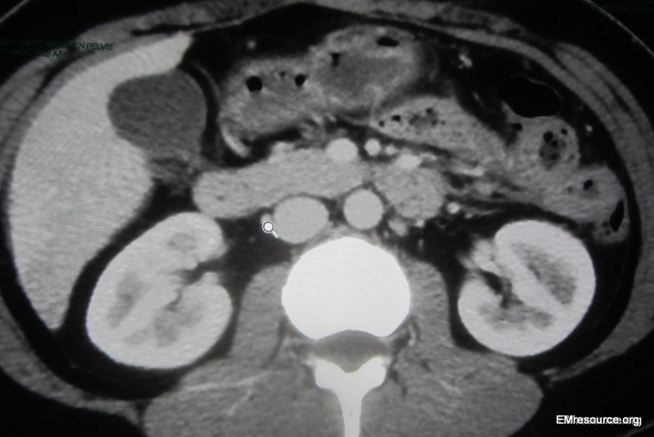- Clinical Technology
- Adult Immunization
- Hepatology
- Pediatric Immunization
- Screening
- Psychiatry
- Allergy
- Women's Health
- Cardiology
- Pediatrics
- Dermatology
- Endocrinology
- Pain Management
- Gastroenterology
- Infectious Disease
- Obesity Medicine
- Rheumatology
- Nephrology
- Neurology
- Pulmonology
Rib Pain on Inhalation in a Young Woman
The patient also has pain when she laughs. Physical examination and lab results are all normal -- with one exception. Can you make the diagnosis?
Figure 1. CT chest (click to enlarge)

A 35-year-old woman with no prior medical history presents to her local emergency department accompanied by her new boyfriend for right sided abdominal and chest pain. The pain is located anteriorly in the right lower chest area and radiates to the right upper abdomen. It has been present for the past 4 days and seems to be gradually worsening. She notes that the pain is much more severe when she laughs or takes a deep breath. She denies fever, cough, dyspnea, or leg swelling. She also denies diarrhea, vomiting, pelvic pain, dysuria, or vaginal discharge, and has no other complaints.
On physical examination her vital signs are normal and her skin is warm and dry without rash. Head and neck examinations are normal without icterus or JVD. Lungs are clear without rales but she is splinting with obvious discomfort when she takes a full breath. There is mild RUQ tenderness but no rebound or CVA tenderness. The legs show no swelling or chords.
Results of laboratory tests, including a CBC, UA, chemistry, pregnancy test, and LFTs are all completely normal, but there is a markedly elevated D-dimer. A chest x-ray is normal. VQ (ventilation-perfusion) scan is available and would normally be the initial test of choice to rule out pulmonary embolism in a woman of this age because of its lower radiation exposure. However, in this case a CT chest is ordered because it will also image the organs of the upper abdomen.
The CT scan is read by the radiologist as negative for pulmonary embolism (PE) or any other pathology. A slice of the CT is shown in the Figure 1 (click image to enalrge) and demonstrates a subtle diagnostic finding that was missed by the radiologist.
What is the finding? What is the diagnosis?
(NB: Don’t spend too much time; as noted, this is a subtle one, but look carefully. Then click link for the answer, discussion, and an important clinical pearl.)
